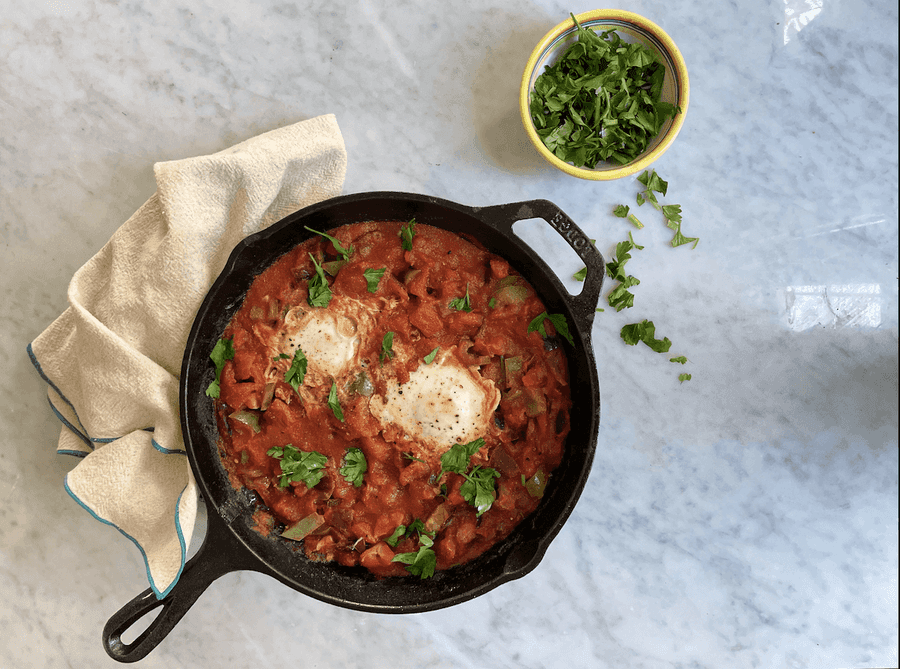Lycopene Pumped Shakshuka
by Amylee Amos PhD, RDN, IFMCPRecipes
Shakshuka is a middle eastern vegetable and egg dish that likely originated in Turkey or northern Africa. It is very popular in the middle east, and different countries in the region each have their own variation on the dish, all of them absolutely delicious. Shakshuka is packed with flavor and is a great way to get in vegetables with breakfast, which is not always easy to do.
But here’s why I really love this dish: it combines cooked tomatoes with olive oil. Not only do those two items taste great together, they allow for a synergistic nutritional effect to occur. Let me clarify. The pigments of red and orange vegetables and fruits contain phytochemicals called carotenoids. Carotenoids have been extensively studied for their benefits to eye health and for their antioxidant potency, making them a focus for cancer research (1). Tomatoes, and other red vegetables and fruits like pink guava and watermelon, contain a specific carotenoid called lycopene (2). Lycopene is best known for its role in prostate cancer prevention, although its benefit has been studied in a variety of different cancers (3). The issue is, lycopene is not very bioavailable, meaning it is not easily absorbed into the body, even though it may be often consumed. The two things that make lycopene, from tomatoes, better absorbed or more bioavailable are heat and fat. When the tomatoes are heated, like when you cook tomatoes, the lycopene changes its chemical form, transforming its chemical structure into one that is better absorbed (4). Additionally pairing tomatoes with a fat, like adding olive oil, enhances absorption because lycopene is lipophilic or fat soluble. The bottom line is, to get the benefits of lycopene, you need to cook the tomatoes in a healthy fat.
What I find fascinating about that is that ancient cultures who have cooked tomatoes in olive oil for centuries never knew all that nutrition science, yet they did everything right anyways. We’ve basically spent decades doing the hard research, just to find out that our great-great-great-great grandmothers knew that this was the best way all along. We’ve come full circle.
Anyways, lycopene in particular has been extensively studied for its antioxidant benefits, specifically pertaining to cancer. The actual research is conflicting, likely because lycopene can be consumed from nutritious foods like tomatoes, or from nutritional nightmares like ketchup (which is often loaded with high fructose corn syrup). Studies of nutritional components are often conflicting because we don’t eat things in isolation, so there are always confounding factors (5). What we know without a doubt is that nutrition plays a critical role in carcinogenesis, whether in a favorable or unfavorable way. Eating a diet high in fruits and vegetables, and consuming lycopene from foods, can only enhance your health. Believe me when I say that your body needs more whole food antioxidants to fight free radicals and prevent carcinogenesis. So try out this Shakshuka recipe, absorb all the lycopene goodness, and enjoy!
This recipe serves 1.
Ingredients:
- 1 tablespoon of extra virgin olive oil*
- 3 cloves garlic, minced
- ½ cup white onion, chopped
- 1 cup green bell pepper, chopped
- 1 teaspoon cumin
- 1 teaspoon paprika
- 1 ½ teaspoon coriander
- ¼ teaspoon sea salt
- ¼ tsp black pepper or Aleppo pepper
- 3 large vine ripened tomatoes
- 2 pasture raised eggs
Directions:
- In a cast iron skillet or stainless steel pan, heat the olive oil over low heat.
- Add the garlic and onion and saute about 3 minutes until the onion is translucent.
- Add the bell pepper, cumin, paprika, coriander, salt, and pepper to the pan and saute 3-4 minutes.
- Halve the tomatoes and put them in a food processor and pulse a few times so the liquid is released, but they still have a bit of texture.
- Pour the tomatoes into the pan and stir. Saute for 3-4 minutes.
- Create little wells in the Shakshuka mixture, then crack the eggs directly into the divots.
- Cover your pan with a lid, and simmer until the egg whites are no longer translucent.
- Serve immediately.
*Note: Make sure to keep your temperature low when cooking with olive oil, as it has a relatively low smoke point.
References:
- Johnson, E.J., (2002). The role of carotenoids in human health. Nutr Clin Care, 5 (2):56-65.
- Shi, John, et al. (2004). Antioxidative properties of lycopene and other carotenoids from tomatoes: synergistic effects. BioFactors, vol. 21 (1-4): 203–210.
- Etminan, M. et al. (2004). The role of tomato products and lycopene in the prevention of prostate cancer: a meta-analysis of observational studies. Cancer Epidemiol Biomarkers Prev, 13(3): 340-345.
- Dewanto, V. et al. (2002). Thermal processing enhances the nutritional value of tomatoes by increasing total antioxidant activity. J Agric Food Chem, 50(10):3010-4.
- Greger, M. (2017, November 1). Lycopene Supplements vs. Prostate Cancer. Retrieved from: https://nutritionfacts.org/video/lycopene-supplements-vs-prostate-cancer/